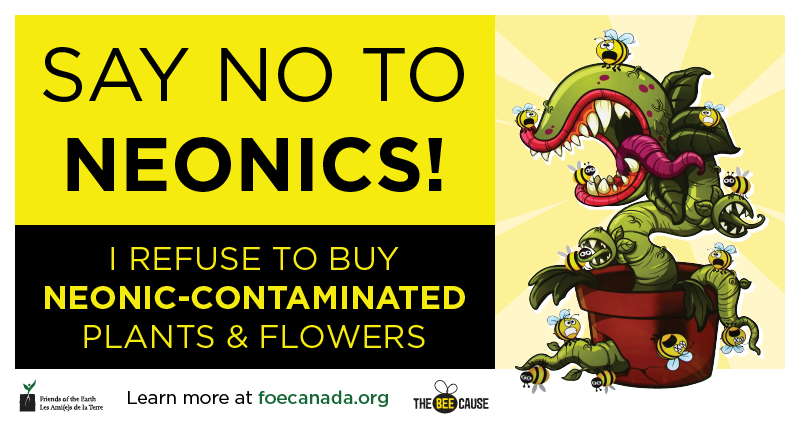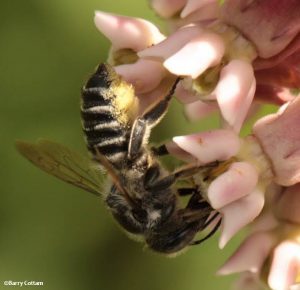by Renate Sander-Regier
In almost the same breath one day in April, two important and loosely related announcements were issued regarding wild bees and agricultural chemicals.
First, a group of Canadian environmental organizations shared news regarding their court case to protect pollinators from destructive neonicotinoid pesticides. They announced that the joint lawsuit involving Canada’s Pest Management Regulatory Agency (PMRA) will proceed to a full hearing (see notice) despite efforts by the federal government and pesticide producers to shut it down. The lawsuit declares that it is unlawful for the agency to register neonicotinoid pesticides for use in Canada without the scientific information necessary to gauge the risk to pollinators.
An article released the same day outlines the results of recent research into wild bees and agricultural chemicals. The study, by pollinator researchers in the United States, sought to understand how solitary native bees interact with pesticides. The results illustrate what the PMRA court case is all about: the need to know more about the risks of chemical exposure on a wide range of pollinators before authorizing pesticide use.
The researchers start by setting the contemporary context. They point out that research and media attention has typically concentrated on the Honey Bee, and that pest management regulators typically check the effects of chemicals on that species before authorizing use.
Yet wild bees also face many challenges, including pesticide exposure, and not much is known about their response to agricultural chemicals. Solitary wild bees, who nest mostly in tunnels such as hollow plant stems, holes in wood, and underground burrows, can interact with pesticides in very different ways. And those interactions can occur at various points and periods (some long) during a solitary bee’s life cycle.
The interactions are fascinating, and it is worth looking at the published research article to see the depictions of the interactions, and to read about them in detail. For now, here is an overview:
-
adult wild bees can ingest contaminated nectar or pollen when they forage to maintain energy or to support egg development
-
wild bee larvae can ingest contaminated nectar or pollen while they are developing in the nest
-
adult wild bees can come into contact with contaminated plant material or soil while gathering materials for nest construction, and while foraging
-
adult wild bees can transmit chemical compounds internally, directly to the egg
These various routes of pesticide exposure can have different effects, resulting in consequences that are potentially much higher for solitary bees. One of the researchers, Theresa Pitts-Singer, makes an important distinction between the costs of exposure to Honey Bees and to solitary wild bees. She is quoted in the research summary as saying:
“A nesting season, as well as pollination service, ends for a cavity-nesting bee if she is killed or lost due to pesticide effects, while negative pesticide effects on only some of the worker bees from a honey bee colony would not end the life of the hive nor the complete function of honey bees as pollinators. In this context, the cavity-nesting bees – or any solitary bees – are more vulnerable to negative effects of pesticides.”
The researchers acknowledge that their study is an incomplete assessment of pesticide safety for pollinators, and that it leaves many questions unanswered. They nevertheless identify the pesticides of most concern: those that easily contaminate pollen and nectar, impacting both adult and larval stages, followed by pesticides expressed in leaves and persistent in soils.
More information
About the solitary bees and pesticides study
- Beyond the honey bee: how pesticides affect solitary, cavity-nesting bees offers an overview of the study
- Routes of pesticide exposure in solitary, cavity-nesting bees is the article published by the researchers
About the court case involving Canada’s Pest Management Regulatory Agency (PMRA)
- Friends of the Earth Canada: This story will make you angry
- Ecojustice: Protecting pollinators from neonicotinoids
- David Suzuki Foundation: Canada should ban bee-killing neonics in 2018!
Renate Sander-Regier has a passion for wild bees. She seeks to encourage them and other native pollinators in different habitat planting projects – at her rural home, the Fletcher Wildlife Garden, the University of Ottawa campus, and more.


Renate Sander-Regier, you quoted from Theresa Pitts-Singer’s ‘Research Summary’ that “… negative pesticide effects on only some of the worker bees from a honey bee colony would not end the life of the hive nor the complete function of honey bees as pollinators… “ Sadly, more recent information has shown this is not true.
NeoNics are lipophilic, so build up in the wax of the hive where their cumulative, neurotoxic effects – particularly during the constant exposure while overwintering inside the hive – have been found to be exponentially worse than direct exposure to the insecticides themselves.
Just as it was documented so many decades ago in Rachel Carson’s ‘Silent Spring’ – how the application of DDT affected many species up the Food Chain and culminating with thinning shells of Raptor eggs and resultant decline in their populations – we must protect Pollinators of ALL types from the effects of NeoNicotinoid Insecticides as they; whether bat, bee, bird, butterfly or earwig; and the species which depend upon them for food, are equally susceptible…
Might I also suggest that blog posts be dated so readers know how current is the information contained within?